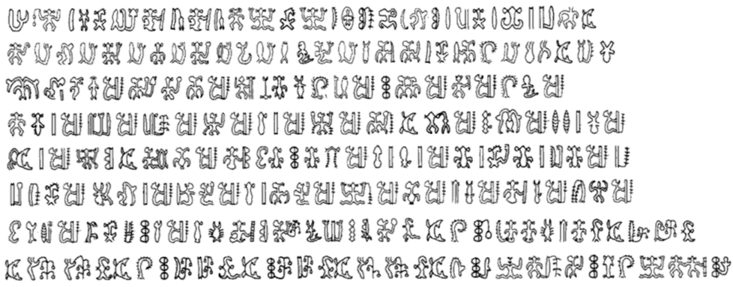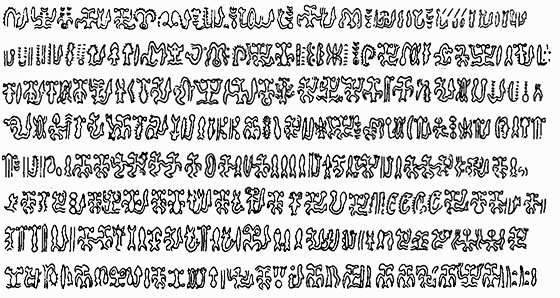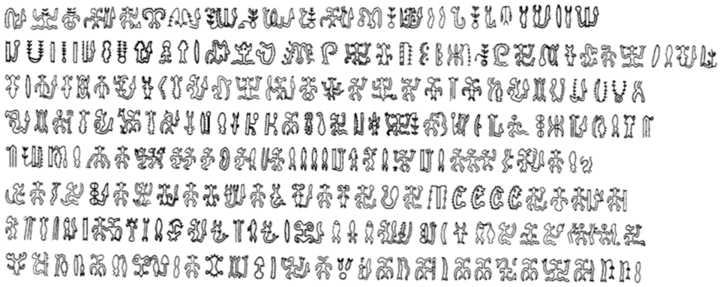
Rongorongo text G
Encyclopedia
.jpg)
Text G of the rongorongo
Rongorongo
Rongorongo is a system of glyphs discovered in the 19th century on Easter Island that appears to be writing or proto-writing. It cannot be read despite numerous attempts at decipherment. Although some calendrical and what might prove to be genealogical information has been identified, not even...
corpus, the smaller of two tablets located in Santiago and therefore also known as the Small Santiago tablet, is one of two dozen surviving rongorongo texts. It may include a short genealogy.
Other names
G is the standard designation, from BarthelThomas Barthel
Thomas Sylvester Barthel was a German ethnologist and epigrapher who is best known for cataloguing the undeciphered rongorongo script of Easter Island....
(1958). Fischer (1997) refers to it as RR8.
Location
Museo Nacional de Historia Natural, Santiago. Catalog # 5.497 (314).There are reproductions at the Musée de l'Homme
Musée de l'Homme
The Musée de l'Homme was created in 1937 by Paul Rivet for the 1937 Exposition Internationale des Arts et Techniques dans la Vie Moderne. It is the descendant of the Musée d'Ethnographie du Trocadéro, founded in 1878...
, Paris; Padri dei Sacri Cuori
Congregation of the Sacred Hearts of Jesus and Mary
The Congregation of the Sacred Hearts of Jesus and Mary and of the Perpetual Adoration of the Most Holy Sacrament of the Altar is a Roman Catholic religious order of brothers, priests, and nuns...
(SSCC), Rome; Museum of Mankind, London; Ibero-Amerikanisches Institut, Berlin; Bishop Museum
Bishop Museum
The Bishop Museum , is a museum of history and science in the historic Kalihi district of Honolulu on the Hawaiian island of O'ahu...
, Honolulu; Department of Anthropology, National Museum of Natural History, Smithsonian Institution
Smithsonian Institution
The Smithsonian Institution is an educational and research institute and associated museum complex, administered and funded by the government of the United States and by funds from its endowment, contributions, and profits from its retail operations, concessions, licensing activities, and magazines...
, Washington; American Museum of Natural History
American Museum of Natural History
The American Museum of Natural History , located on the Upper West Side of Manhattan in New York City, United States, is one of the largest and most celebrated museums in the world...
, New York; van Hoorebeeck Collection, Belgium; and in Steven Fischer's collection in Auckland.
Physical description
.jpg)
Provenance
In 1870 Father RousselHippolyte Roussel
Hippolyte Roussel was a French priest and missionary to Polynesia, a member of the Congregation of the Sacred Hearts of Jesus and Mary.In 1854 he was sent to evangelize in the Tuamotus and Mangareva in the Gambier Islands...
gave tablets G and H to Captain Gana of the Chilean corvette O'Higgins. They remained in the custody of the Chilean navy in Valparaíso until they were sent to the newly established department of archeology at the Museo Nacional de Historia Natural.
Contents
In 1956 Butinov and Knorozov noted that the structure of a sequence of 15 glyphs in Gv6 suggested that it was a genealogy: A son of B, B son of C, C son of D, ... The final glyph 76 in each sequence, which Fischer (1997) sees as a phallus, would thus be a patronymicPatronymic
A patronym, or patronymic, is a component of a personal name based on the name of one's father, grandfather or an even earlier male ancestor. A component of a name based on the name of one's mother or a female ancestor is a matronymic. Each is a means of conveying lineage.In many areas patronyms...
taxogram and would mark personal names on other tablets, something which Guy (1998) considers to be a reasonable interpretation.
Several scholars have noticed that tablet G contains two structurally very different texts. Most of Gr is paraphrased as text K, while the last line and a half of Gr and the whole of Gv share short phrases with I
Rongorongo text I
Text I of the rongorongo corpus, also known as the Santiago Staff, is the longest of the two dozen surviving rongorongo texts. Statistical analysis suggests that its contents are distinct.-Other names:...
and T
Rongorongo text T
Text T of the rongorongo corpus, also known as Honolulu tablet 1 or Honolulu 3629, is the only fluted tablet in the Honolulu collection and one of two dozen surviving rongorongo texts.-Other names:...
(or at least Ta) but not the rest of the rongorongo corpus (Pozdniakov 1996:290, 299).
Text
Eight lines of glyphs on each side, for ~ 720 glyphs in all.Harrison (1874:379) noticed that lines Gr3-7 feature a compound glyph, 380.1+3 (a figure on a vertical rod with a garland), repeated 31 times, each followed by up to half a dozen glyphs before the next. He thought that the figure broke the text into sections, each of which contained the name of a chief. Fischer agrees that the appear to be names, and Guy (2001) identifies the garland as a determinative
Determinative
A determinative, also known as a taxogram or semagram, is an ideogram used to mark semantic categories of words in logographic scripts which helps to disambiguate interpretation. They have no direct counterpart in spoken language, though they may derive historically from glyphs for real words, and...
of royalty.
Most of the recto (lines 1-7) is repeated with little change on the younger London tablet
Rongorongo text K
Text K of the rongorongo corpus, also known as the London tablet, is one of two dozen surviving rongorongo texts, and nearly duplicates the recto of tablet G.-Other names:...
; after this the structure of the text changes radically, making the last line and a half of Gr and the whole side of Gv distinct from the rest of the rongorongo corpus. In addition, Pozdniakov found a brief sequence of glyphs that crosses from Gr8 to Gv1, confirming Barthel's reading order.
Recto
-

- Recto, as traced by Barthel. The lines have been rearranged to reflect English reading order: Gr1 at top, Gr8 at bottom.
-

- Recto, as traced by Fischer.
Verso
-

- Verso, as traced by Barthel: Gv1 at top, Gv8 at bottom.
-

- Verso, as traced by Fischer.

